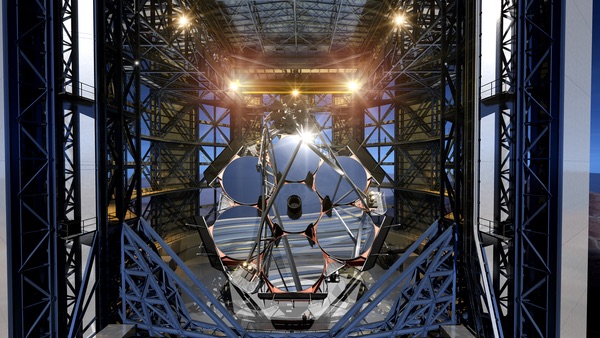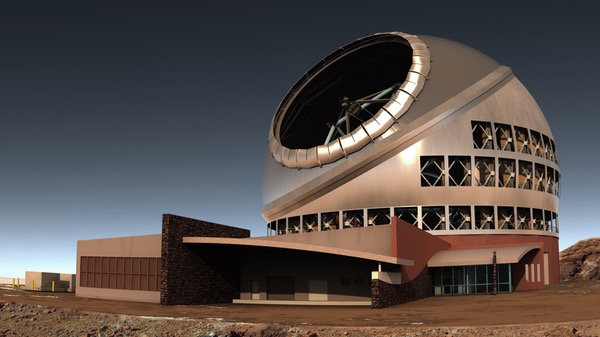The era of extremely large telescopesby Jeff Foust
|
| “Maunakea certainly remains our preferred site for TMT. ORM is an excellent alternative should Maunakea prove impractical,” said Soifer. |
At the same time, the organization was developing a backup plan. In October 2016 it announced the selection of a backup site, Observtorio del Roque de los Muchachos (ORM) on La Palma in the Canary Islands. Planning for developing TMT there has been going on in parallel with the ongoing legal process in Hawaii. At a meeting last January of the American Astronomical Society (AAS) in Texas, telescope officials suggested a decision on whether the build TMT in Hawaii or La Palma would be made by that fall (see “Decision time for the Thirty Meter Telescope,” The Space Review, January 9, 2017).
A year later, that decision is still forthcoming, but project officials said they plan to make a choice soon. “Maunakea certainly remains our preferred site for TMT. ORM is an excellent alternative should Maunakea prove impractical,” said Tom Soifer, a Caltech physics professor and member of the board of the TMT International Observatory, during a town hall meeting about the telescope at the AAS meeting early this month in suburban Washington. “Our board, the TIO board, will be making a decision about the site in the spring of 2018, with a plan to initiate construction as soon as possible thereafter.”
The two sites will be in different stages of readiness if the TIO board sticks to that schedule. The TMT won a victory in Hawaii in September when the Hawaii Board of Land and Natural Resources approved a new construction permit for the telescope atop Maunakea. But, Soifer noted, opponents of the telescope appealed the decision to the Hawaii Supreme Court, even as the state appealed the ruling the required the contested case hearing in the first place. “You’d be amazed at all of the things lawyers can find to do,” he said.
On La Palma, the process has been much smoother. Construction planning documents are nearly complete for the ORM site, Soifer said, and an environmental impact had been submitted to the local government. With no evidence of significant opposition to the telescope, he said he expected the government to issue a permit for building TMT there by February or March.
Maunakea, though, remains the preferred site for several scientific reasons. The lower latitude of Maunakea will allow the telescope to see more of the southern sky than at ORM. The lower altitude of ORM—more than 1,500 meters below Maunakea—means more water vapor in the atmosphere, affecting infrared observations. “For wavelengths beyond about 2.5 microns, observations for longer wavelengths are compromised” there versus Maunakea, Soifer said.
The legal dispute in Hawaii, though, won’t be completed by the planned April deadline for a decision. “The appeals have been filed, but the court has not made any indication of what it wants to do with those appeals,” Soifer said after the town hall meeting. “The best case would be late spring or early summer of 2018.”
Even if a decision leads to work starting this year, Soifer said it would not be until the late 2020s before the TMT is ready to being observations. “If we start construction during 2018, we should be seeing first light about a decade later,” he said.
 The Giant Magellan Telescope will feature seven mirrors, each more tha eight meters in diameter. (credit: GMT Organization) |
The other large telescopes
TMT is not the only so-called “extremely large telescope” under development. Two others are also in early phases of development in the Southern Hemisphere that have largely escape the controversy surrounding the TMT.
| “If you couldn’t do more than one mirror at a time, it would be hopeless,” McCarthy said. |
One is the European Southern Observatory’s Extremely Large Telescope in Chile. Like the TMT, it will consist of hundreds of small mirror segments—798, to be exact—that will be combined to form a single mirror with a diameter of 39 meters. The observatory announced this month that first six of those segments have been cast at a German factory, keeping the project on track for a first light in 2024.
The other is the Giant Magellan Telescope (GMT), which will also be built in Chile. Unlike the other two projects, it plans to use seven large mirrors, each 8.4 meters in diameter, creating an effective aperture of 24.5 meters. The project started casting the fifth of those seven mirrors in November.
“We’re now at the stage that we’re really into construction. It’s becoming a real thing now. We’re building a lot of optics. We’re under contract to build the telescope and we’re just about to get under contract to starting digging holes on top of the mountain” for the observatory, said Pat McCarthy, vice president for operations and external relations at the Giant Magellan Telescope Organization, in an interview during the AAS conference.
By 2021, he said, “things will really start to show up on the mountain” as the observatory building nears completion. By 2024 and 2025, he said, the mirrors will be installed and operations will begin.
Building the mirrors, he said, is the long pole in the project schedule, taking about five years to go from a pile of glass to a completed, polished mirror. “If you couldn’t do more than one mirror at a time, it would be hopeless,” he said. “We can be working on four to five at a time.”
Those mirrors posed a number of technical challenges. That size, he said, is near the maximum feasible size for a monolithic mirror, given factors ranging from the time it takes for the glass to cool after casting to its weight and risk of breakage. While other telescopes, like the TMT and the Extremely Large Telescope, are using large numbers of small segments to create a large mirror, “we’ve gone the other approach, deciding it’s best to have as much contiguous surface area as you can, so we make the biggest possible segments.”
However, not all the segments are alike: the seven segments have to be aligned so that most of them have off-axis shapes. “You have to polish eight-meter mirrors that have off-axis figures, and that’s turned out to be hard,” McCarthy said. “That was the biggest technical challenge: how do you make these complex, off-axis mirrors.” The project has figured out how to do so, he said, and is now looking at how to speed up the production process.
Another challenge is the telescope enclosure, which eschews the standard spherical dome shape for a cylindrical structure that is the equivalent of a building 20 to 22 stories tall. That structure needs to move around and be open as well. The project, he said, brought in Boeing to leverage its expertise in computational fluid dynamics and wind tunnel testing to model the structure’s aerodynamics.
“While we are not flying, we are experiencing some of the aerodynamics effects, the turbulence effects, which they deal with,” he said of Boeing. “They’ve been a very good partner helping us model the structure and optimize some of the architectural choices before we finalize those in concrete.”
There are also financial challenges. The GMT has an estimated cost of $1 billion, and when the project started its various partners provided more than $500 million to begin development, with some more raised since. “That’s enough to get us through all the remaining design work, keep the mirror production going, to start the construction,” he said.
| “The global community of people working on these big telescopes are all interested in pretty much the same big science questions,” he said. “Where did we come from? What’s the universe made of? How is it evolving? Where are we going?” |
However, the project still needs to raise an undisclosed amount to fully pay for the telescope. “We’ve got a fundraising operation that is up and running. We’re making good progress with meeting with prospective donors,” he said. “I think we’re in good shape on that. It’s just going to be an uphill climb.”
One advantage McCarthy said that the GMT will have over the other two large telescopes is that its “fast” optical design and wider field of view. “Because of this compact optical nature, it’s easy for us to build conventional instruments: conventional spectrographs, conventional cameras,” he said.
One of the initial instruments available at the GMT will be high-precision, high-resolution spectrometer, which the other two observatories will not have when they open since the optical designs of those telescopes make such instruments more difficult to design. “TMT and the European ELT will have those eventually, but they’re much harder to build,” he said. “It probably will take them a little longer.”
Ultimately, though, all three extremely large telescopes, whenever and wherever they’re completed, will be doing similar science. “The global community of people working on these big telescopes are all interested in pretty much the same big science questions,” he said. “Where did we come from? What’s the universe made of? How is it evolving? Where are we going? These are the basics that we all are dealing with, but the structure of how you go about it differs from one project to another.”
